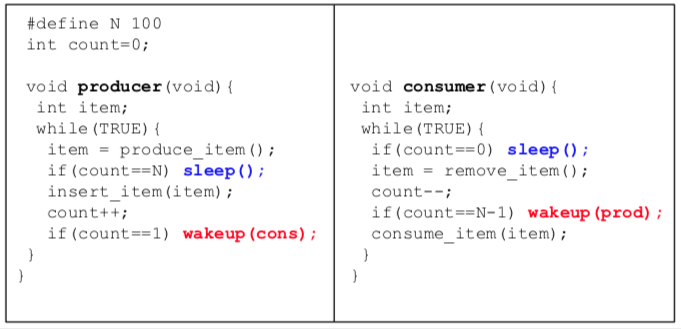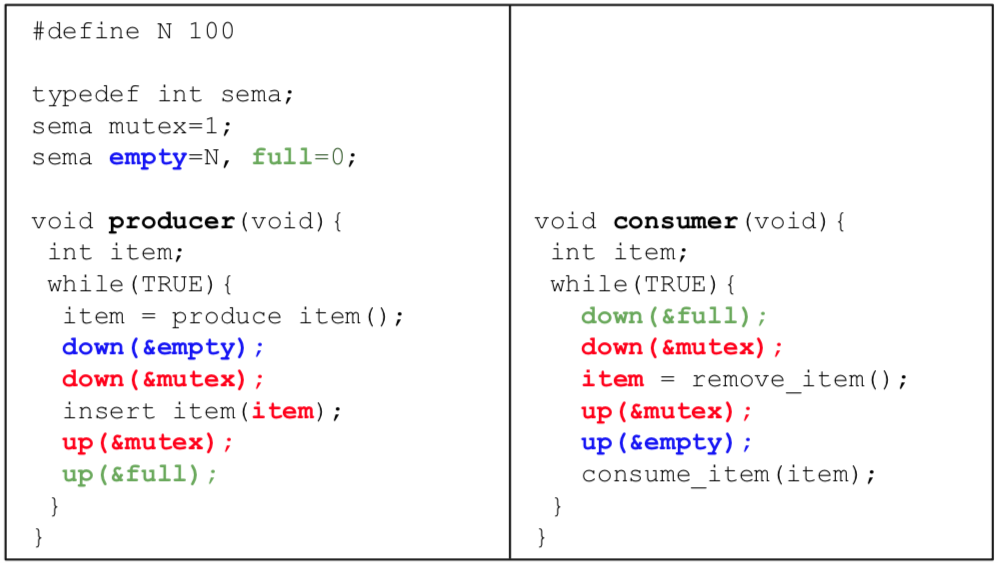Operating Systems
Table of Contents
Race conditions & mutual exclusion
programs can race each other and come to wrong conclusions.
Mutual exclusion
critical region: a code region with access to shared resources
the conditions for mutual exclusion:
- no two processes can be simultaneously in their critical regions
- no assumptions can be made about speed/number of CPUs
- no process running outside critical region may block others
- no process should have to wait forever to enter critical region
non-solutions
- disable interrupts (disable reallocation of CPU). if you have multiple processors, shit gets fucked.
- lock variables (guard critical regions with booleans). so now the race is on the lock variables, great job dude.
- strict alternation (be nice and take turns). doesn’t allow processes to enter critical regions twice in a row, and a process outside the critical region can block another one.
Peterson’s algorithm
- software solution
- spin lock in the while loop
#define N 2
int turn;
int interested[N];
void enter_region(int process){
int other = 1 - process;
interested[process] = TRUE;
turn = process;
while(turn==process && interested[other]==TRUE);
}
void leave_region(int process) {
interested[process] = FALSE;
}
TSL instruction
- hardware-assisted solution to mutual exclusion problem
- atomic test and set of a memory value
- spin until LOCK is acquired
enter_region:
TSL REGISTER, LOCK | copy LOCK to register, set LOCK to 1
CMP REGISTER, #0 | was LOCK zero?
JNE ENTER_REGION | if it was non-zero LOCK was set, so loop
RET | return to caller; critical region entered
leave_region:
MOVE LOCK, #0 | store a 0 in LOCK
RET | return to caller
Avoiding busy waiting
so far, CPU busy waits until it can enter the critical region (spin lock). so, let process waiting return CPU to scheduler voluntarily.
void sleep() {
set own state to BLOCKED;
give CPU to scheduler;
}
void wakeup(process) {
set state of process to READY;
give CPU to scheduler;
}
Producer-consumer
- producer sleeps when buff is full
- consumer sleeps when buff is empty

- problem: wake up process may get lost. only wake up producer when count is N-1, but producer sleeps when count is N.
Semaphores
- introduce sema integer type with operations:
- down: if sema ≤ 0, block calling process. sema– otherwise.
- up: if there is process blocking on sema, wake it up. sema++ otherwise.
- OS guarantees that all the operations are atomic (happening instantaneously) by design — disable interrupts on single processors, spin locking on multiprocessors.
- mutex (mutual exclusion) variable serialises access to shared buffer

Monitors
- semaphores introduce chaos in programs (gotta set all them bits)
- monitors: serialise procedure calls on a module, use condition vars to wait/signal processes
- but this needs dedicated language support

Message passing: solution to process sync and communication
- processes interact by sending & receiving messages.
- most common in multiserver OS designs
- issues — mem copying vs register passing (efficiency), mailboxes vs rendezvous